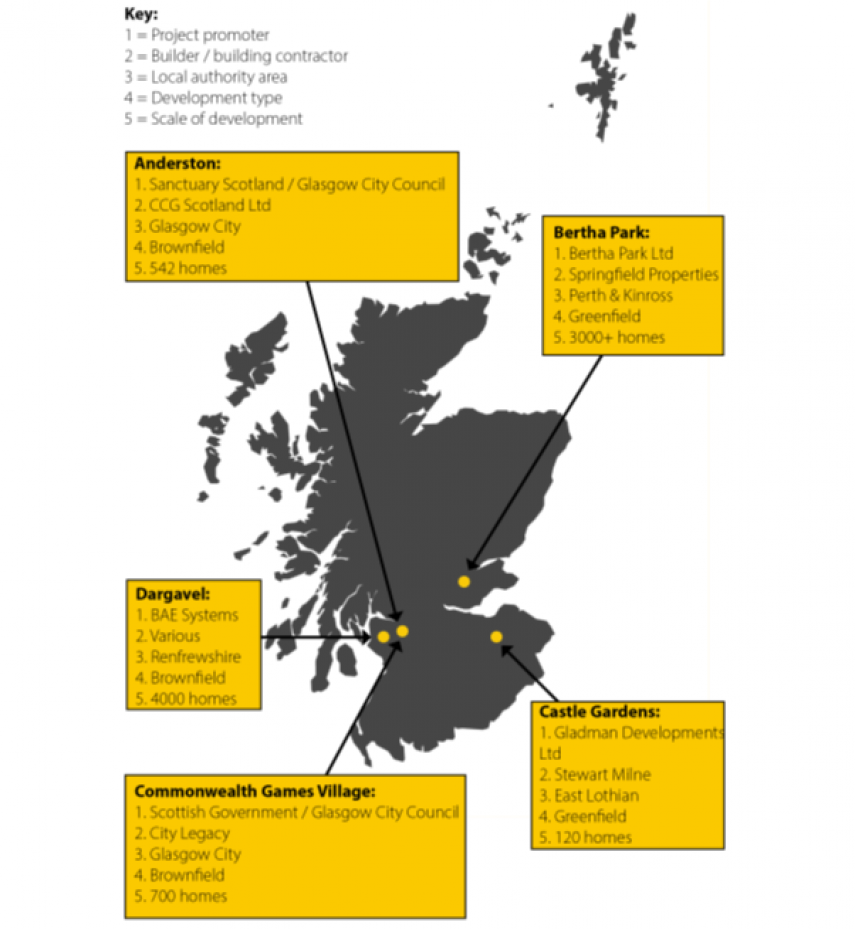
Delivering more homes and better places in Scotland
Dr Gareth James
In this guest blog, Dr Gareth James summarises the findings from "Delivering more homes and better places: Lessons from policy and practice in Scotland," a report co-produced with the Housing and Place Delivery Forum and jointly published by CaCHE and the Scottish Land Commission, published today as part of our Review of Land for Housing and Development.
For Scotland to thrive in the decades ahead, it needs to deliver more high-quality, sustainable homes and places for everyone. In our report, we examine five housing developments in Scotland in order to extract lessons for future housing and place delivery. The main objectives of our research were to:
- Identify land-related barriers to housing delivery and place-making in Scotland
- Examine cases of recently completed and contemporary housing development in Scotland, including the approach to land assembly and place-making in each case
- Summarise key practical lessons for housing and place delivery in Scotland.
Our approach involved a multiple case study design and, for each case, we drew on evidence obtained from planning documents, key informant interviews, and stakeholder workshops. The five cases study sites, along with some summary information, are included in Figure 1, below.
In the report, we explore some of the factors driving the need for more homes and better places in Scotland, before moving to outline some of the complexities of land, policy and investment that can enable or prevent new housing supply and place-making. In particular, we have shown how the operation of residential land markets, weaknesses in the planning system, short-termism, and political choices have seen us fall behind some of our closest European neighbours.
Our assessment of the five Scottish case studies is summarised in Table 1. While there are clearly positive place-making elements in all five cases, none meets fully all of the criteria for ‘successful places’ that we set out in the report.
Building on our assessment of these case studies, and drawing on key informant interviews and the output from two stakeholder workshops, we identify nine practical lessons, which could help to ensure more consistent delivery of high-quality, sustainable homes and better places in Scotland in the future.
The nine lessons are:
- Local Planning Authorities should allocate a wide range and mix of housing sites, at different sizes and scales, and in different locations, to achieve a balance of tenures and dwelling types.
- The Local Development Plan should be relevant, robust and outcomes-focused; and councils must commit to delivering the Plan once it has been adopted.
- Local development planning must engage communities at the point where decisions of principle are made. Community engagement is also essential in shaping projects so that they link to and support the wider neighbourhood interest.
- There is a role for place-making champions within local authorities. For large-scale sites, in particular, the public sector may be required to assist in land assembly and delivering public interest elements of development. In places of low value or market value, local authorities need to help shape markets to generate production confidence.
- Large-scale development proposals require a substantial commitment to up-front investment in infrastructure. Furthermore, where there is a wider public benefit, the public sector should participate in the funding of up-front infrastructure.
- Collaboration between developers, local planning authorities and landowners is essential to making success of large-scale, long-term projects.
- Masterplans should establish place-making principles but have some flexibility to accommodate change as time and circumstances progress.
- Landscaping is part of the place-making process and should not be treated as a sub-ordinate element within a masterplan.
- The Climate Emergency demands more radical policy intervention in new housing development.
We expand on each of these points in the report but we recognise that none of these ‘lessons’ are new. Nearly twenty years ago, Sam Galbraith, the Minister responsible for Scottish planning, challenged planners by asking, “where are the conservation areas of tomorrow?” As a result, a whole raft of national planning design guidance was generated and that continues today. Of the five case studies we examined, we suggest that the Glasgow Commonwealth Games Village comes closest to being considered a ‘successful place.’
However, the pursuit of good place-making in Scotland continues, with the jury still out as to whether responses to Galbraith’s challenge have been successful. We conclude that, ultimately, local authority planning departments – along with the wider public sector and government as a whole – need to be more proactive and confident in land assembly, land allocation and public interest-led development if Scotland is to be successful in its ambition to deliver more homes and better places.

This report provides some clear and constructive lessons on how the way land is assembled for development can deliver more homes and better places. It is one of a series of reports that make up the Commission’s Review on Land for Housing & Development. The review will report later this year and the key findings from these case studies will inform and contribute to the final recommendations.
- David Stewart, Senior Policy and Housing Officer, Scottish Land Commission